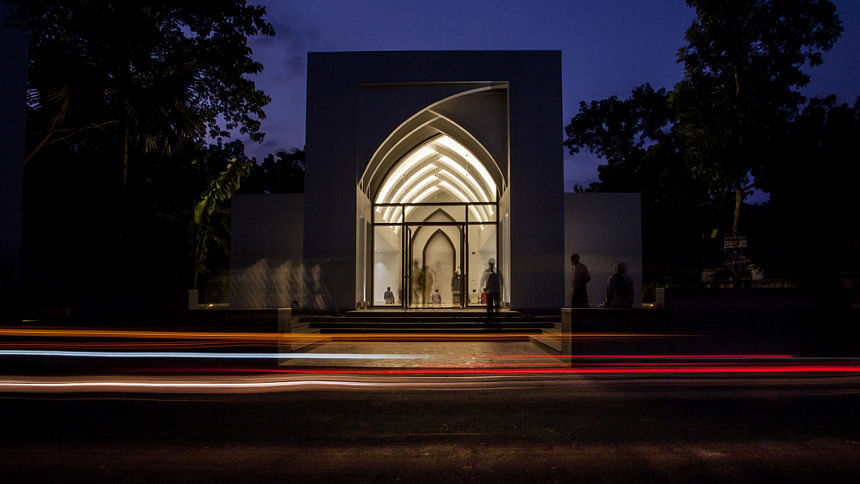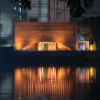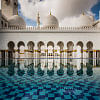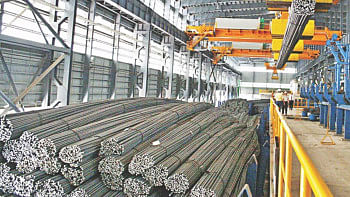Evolving mosques in Bangladesh

They are important elements of the cultural and collective lives of Muslim communities, and thus mosque construction and design are representative of each community. Which is why, while mosques in different parts of the world have similarities, modern architecture is inspiring newness in mosque design everywhere. In Bangladesh, many new mosques with their edgy architecture are reflecting changes in the populace's changing mores.
Bait Ur Rouf Mosque
The first and obvious one that comes to mind is the internationally acclaimed Bait Ur Rouf Mosque in Dakshin Khan, Uttara in Dhaka. Designed by architect Marina Tabassum, this mosque was built in 2012 and won the Aga Khan Architecture Award. Atypical to most mosques, Bait Ur Rouf Mosque does not have any domes or minarets, and even the prayer hall has no pillars inside, but relies on eight peripheral columns. There are numerous circular openings in the ceiling and walls, which let natural light enter the structure throughout the day, creating interesting patterns inside, and the structure also allows for ventilation. It has a capacity of 500-600 people at a time, and has an austere yet welcoming spiritual ambience. The entire outside façade is made of terracotta bricks, and has no decoration.
Amber Denim Mosque
Nestled between greenery and surrounded by a pool lies the Amber Denim Mosque, inside the factory premises of Amber Denim Mill in Jangalbaria, Gazipur. With a structure emblematic of austerity, the construction utilised materials already on site, and the design boasts elements of modern tropical architecture. There is no minaret or dome at all, and the surrounding pool creates an illusion more associated with a charming holiday cottage, invoking expectation of tranquillity.
Bricks and handmade solid cement blocks are used to create trellis walls, allowing free flow of air and light, making the mosque completely naturally ventilated.
The Amber Denim Mosque is the brainchild of Lutfullahil Majid, partner in Archeground Ltd. and recipient of the Berger Young Architect Award in 2015.
Mayor Mohammed Hanif Mosque
A public works project by the Dhaka South City Corporation, this 16,500 sq ft mosque is in Azimpur, Dhaka, beside the Azimpur Graveyard. Built by Rafiq Azam of Shatotto, this is modern construction with inspiration drawn from Mughal-built Azam Shah mosque in Lalbagh. There is a large central terrace, traditionally inspired, and a tall column that serves as the lone minaret, but also as an elevator shaft for the multistorey building.
The central main hall is held up by cement columns with lotus leaf canopies, creating the illusion of an indoor forest. The western wall is largely glass and frosted glass, and windows in the north and east let daylight illuminate the entire room.
Prayer panels are indicated by lights embedded into the floor, for a sleek finish. The entire first row is for the imam, and there is no mehrab, but the entire western wall in stark redbrick, creating a beautiful contrast. There is also a separate and dedicated space for female worshippers.
Mohor Para Mosque
According to the designing firm, And Orden, the mosque was visualised as the 'rural lantern' and true to that concept, it glows from within at night, like a beacon for devotees. Built in 2014 and created by architects A K M Tanvir Hassan Niru, Nahid Akram, and Manifa Rehnuma, it was shortlisted for the 3rd cycle of Abdullatif Al Fozan award in 2019 for its design. The mosque also won the prestigious 27th JK Cement Award in foreign category — Young Architect of the Year in 2018.
The structure is reminiscent of traditional mosques with a large prayer hall and a single minaret outside, which stands alone and away from the main mosque, with a heavy dash of modernity in design that allows for natural influx of light during the day, and the illusion of a glowing mosque at night. The rectangular structure's roof has beautiful arches built inside the roof. The interweaving curves being detached from each other create an illusion of oneness, resembling a single pointed arch but representing the abstract connection between believers and the Creator in their detached design, a merger of contemporary architecture, spirituality and symbolism of a traditional mosque's past with the present. Generous use of glass in the walls, windows, and doors, as well as pristine white walls and white tiled floors, and a very low peripheral wall create a very open and serene environment at this village mosque at Mohorpara, in Shibpur, Narsingdi.
50 Model Mosques
The government of Bangladesh is building 560 model mosques all over the country, at district and upazila levels. In ground breaking fashion, all of these mosques will feature prayer spaces for women, as well as offer more common amenities like Islamic research centres, libraries, bookstores, a place to wash and prepare the dead for Muslim burials, as well as host guests and offer Quran memorisation divisions. Ones in the coastal areas will also have disaster shelters on the first floor. Fifty of these model mosques were inaugurated at the same time to mark 50 years of independence of Bangladesh, but most of them are not fully functional yet.
Photo Courtesy: And Orden

 For all latest news, follow The Daily Star's Google News channel.
For all latest news, follow The Daily Star's Google News channel. 








Comments